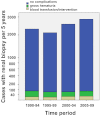Safety and complications of percutaneous kidney biopsies in 715 children and 8573 adults in Norway 1988-2010
- PMID: 22837269
- PMCID: PMC3463204
- DOI: 10.2215/CJN.02150212
Safety and complications of percutaneous kidney biopsies in 715 children and 8573 adults in Norway 1988-2010
Abstract
Background and objectives: Skepticism about performing renal biopsies is often because of uncertainty regarding risk of complications. The aim of this study was to evaluate safety and relevant complications of renal biopsies in pediatric and adult patients in a large national registry study.
Design, setting, participants, & measurements: Kidney biopsies reported in the Norwegian Kidney Biopsy Registry from 1988 to 2010 were included. Risk factors for major complications (blood transfusion and/or surgical or catheter intervention) were analyzed using logistic regression statistics.
Results: Of the 9288 biopsies included, 715 were from children, and 8573 were from adults (≥18 years). Median age was 49 years (range=2 weeks to 94 years). Gross hematuria appeared after biopsy in 1.9% of the patients; 0.9% of patients needed blood transfusion, and 0.2% of patients needed surgical intervention/catheterization. The frequencies were 1.9%, 0.9%, and 0.2% in adults and 1.7%, 0.1% and 0.1% in children, respectively; 97.9% of the biopsies were without complications. In unadjusted analyses, risk factors for major complications were age>60 years, estimated GFR<60 ml/min per 1.73 m(2), systolic hypertension, acute renal failure, and smaller clinical center size (<30 biopsies/yr). Adjusted analyses (adjusted for age and/or estimated GFR) showed higher odds ratios (OR) only for smaller clinical center (OR=1.60 [1.02-2.50]) and low estimated GFR (estimated GFR=30-59 ml/min per 1.73 m(2) [OR=4.90 (1.60-14.00)] and estimated GFR<30 ml/min per 1.73 m(2) [OR 15.50 (5.60-43.00)]).
Conclusions: Percutaneous renal biopsy is a low-risk procedure in all ages. Reduced estimated GFR and smaller center size are associated with an increased risk of major complications.
Figures
Comment in
-
Nephrology and the percutaneous renal biopsy: a procedure in jeopardy of being lost along the way.Clin J Am Soc Nephrol. 2012 Oct;7(10):1545-7. doi: 10.2215/CJN.08290812. Epub 2012 Sep 13. Clin J Am Soc Nephrol. 2012. PMID: 22977210 No abstract available.
Similar articles
-
Desmopressin (Octostim®) before a native kidney biopsy can reduce the risk for biopsy complications in patients with impaired renal function: A pilot study.Nephrology (Carlton). 2018 Apr;23(4):366-370. doi: 10.1111/nep.13004. Nephrology (Carlton). 2018. PMID: 28107603
-
Predictors of complication after percutaneous ultrasound-guided kidney biopsy in HIV-infected individuals: possible role of hepatitis C and HIV co-infection.Clin J Am Soc Nephrol. 2009 Nov;4(11):1766-73. doi: 10.2215/CJN.03880609. Epub 2009 Oct 1. Clin J Am Soc Nephrol. 2009. PMID: 19808221 Free PMC article.
-
Safety of Outpatient Kidney Biopsies.Nephron. 2018;138(4):275-279. doi: 10.1159/000484991. Epub 2018 Jan 4. Nephron. 2018. PMID: 29301131
-
Bleeding Complications after Pediatric Kidney Biopsy: A Systematic Review and Meta-Analysis.Clin J Am Soc Nephrol. 2019 Jan 7;14(1):57-65. doi: 10.2215/CJN.05890518. Epub 2018 Dec 6. Clin J Am Soc Nephrol. 2019. PMID: 30522995 Free PMC article.
-
Systematic Review and Meta-Analysis of Native Kidney Biopsy Complications.Clin J Am Soc Nephrol. 2020 Nov 6;15(11):1595-1602. doi: 10.2215/CJN.04710420. Epub 2020 Oct 15. Clin J Am Soc Nephrol. 2020. PMID: 33060160 Free PMC article.
Cited by
-
Clinical parameters predicting complications in native kidney biopsies.Clin Kidney J. 2019 Oct 19;13(4):654-659. doi: 10.1093/ckj/sfz132. eCollection 2020 Aug. Clin Kidney J. 2019. PMID: 32905412 Free PMC article.
-
Increased risk of renal biopsy complications in patients with IgA-nephritis.Clin Exp Nephrol. 2015 Dec;19(6):1135-41. doi: 10.1007/s10157-015-1121-3. Epub 2015 May 8. Clin Exp Nephrol. 2015. PMID: 25951807
-
Percutaneous Kidney Biopsy and the Utilization of Blood Transfusion and Renal Angiography Among Hospitalized Adults.Kidney Int Rep. 2019 Jul 23;4(10):1435-1445. doi: 10.1016/j.ekir.2019.07.008. eCollection 2019 Oct. Kidney Int Rep. 2019. PMID: 31701053 Free PMC article.
-
Renal biopsy: it is time for pragmatism and consensus.Clin Kidney J. 2018 Oct;11(5):605-609. doi: 10.1093/ckj/sfy075. Epub 2018 Sep 20. Clin Kidney J. 2018. PMID: 30289128 Free PMC article.
-
Renal biopsy practice: What is the gold standard?World J Nephrol. 2014 Nov 6;3(4):287-94. doi: 10.5527/wjn.v3.i4.287. World J Nephrol. 2014. PMID: 25374824 Free PMC article. Review.
References
-
- Cameron JS, Hicks J: The introduction of renal biopsy into nephrology from 1901 to 1961: A paradigm of the forming of nephrology by technology. Am J Nephrol 17: 347–358, 1997 - PubMed
-
- Iversen P, Brun C: Aspiration biopsy of the kidney. Am J Med 11: 324–330, 1951 - PubMed
-
- Alwall N: Aspiration biopsy of the kidney, including i.a. a report of a case of amyloidosis diagnosed through aspiration biopsy of the kidney in 1944 and investigated at an autopsy in 1950. Acta Med Scand 143: 430–435, 1952 - PubMed
-
- Donovan KL, Thomas DM, Wheeler DC, Macdougall IC, Williams JD: Experience with a new method for percutaneous renal biopsy. Nephrol Dial Transplant 6: 731–733, 1991 - PubMed
-
- Yoshimoto M, Fujisawa S, Sudo M: Percutaneous renal biopsy well-visualized by orthogonal ultrasound application using linear scanning. Clin Nephrol 30: 106–110, 1988 - PubMed
MeSH terms
LinkOut - more resources
Full Text Sources
Medical



